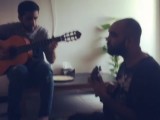![]()
This evening I attended the launch of an unusual art exhibition in Karachi at the Amin Gulgee Gallery. It was called ‘Fresh!’ – 64 artists under 30, and showcased the art of yes, you guessed it, 64 young Pakistani artists from all across the country.
[caption id="" align="alignnone" width="337"]![]() Source: AminGulgee.com[/caption]
John McCarry, coordinator of the gallery, told me that Amin had attended an exhibition in New York at the New Museum called ‘Younger than Jesus’, which showcased artists all under the age of 34.
Source: AminGulgee.com[/caption]
John McCarry, coordinator of the gallery, told me that Amin had attended an exhibition in New York at the New Museum called ‘Younger than Jesus’, which showcased artists all under the age of 34.
“Why not do something like that here?” wondered Amin.
So he found two co-curators, Raania Azam Khan Durrani, founder of the
Commune Artist Colony in Karachi, and Saba Iqbal, a sculpture and printmaking teacher at
Indus Valley School of Arts and Architecture, and decided to make the idea become reality.
They sent out an open call to Pakistani art institutes, university departments and other friends and colleagues in Pakistan’s rich art network. The submissions came pouring in, but from the
hundreds the curators had to narrow it down to only 64, a difficult task, as Amin writes in the catalogue for Fresh!
“I was very committed to representing artists who were not only producing conceptually and technically resolved work, but also those who show promise and are dedicated to their careers as working artists.”
And the search was lucrative indeed, in terms of the talent that they uncovered. Some came from trained backgrounds in large cities, others from small towns in all the four provinces. The catalogue explains it formally.
“We found the creative voice and visual language of a critical mass of Pakistani artists, specifically those at a turning point in their careers, ready to take off and make their individual mark on the national visual identity of Pakistan.”
[caption id="" align="alignnone" width="225"]
![]()
Rickshaw (Qadir Jhatial) Source: FRESH Facebook page[/caption]
But at the exhibition, Amin expressed that in a much more direct way, pointing out the
young artists as they stood proudly in front of their artwork.
“Look! That artist is from Balochistan. That one over there, a really talented fashion photographer, he’s from Gujranwala. And the girl who made the condom dress, she’s from Malakand.”
Condom dress? (*record scratches, music stops*).
Yes, a real live dress hanging from the ceiling, on the second floor of the exhibit, made of hundreds of (unused) condoms (
Is it really protective? Malghalara Kalim). I gasped with surprise when I saw it, then chuckled and then leaned close to look at its design and construction.
[caption id="" align="alignnone" width="337"]
![]()
Condom Dress (Malghalara Kalim). Photo: Bina Shah[/caption]
Next to the dress, another artist stood next to a blue Samsonite vanity case and urged me to look inside the two peepholes she’d made. Inside were miniature hospital wards, complete with white beds and fluffy pillows and screens between the beds.
“What does it mean?” I asked her.
“I made this to show that memory is something you can remember, but you can’t go back to. You can only visit it in your mind in a very limited way,” she told me. (Hireath, Sidra Bukhari)
“Oh, I see.”
I recoiled in horror from a corner of the grand gallery where it appeared that leeches were crawling up the wall. These turned out to be made of iron (
Maggots, Fatima Sabeekah). I admired a painting that made me think of Monet, then peered at the exhibition label only to realise it was called
It Happened on Monet’s Bridge (Sehr Jalil).
[caption id="" align="alignnone" width="527"]
![]()
It happened on Monet's bridge (Sehr Jalil). Source: FRESH Facebook page[/caption]
I stopped in front of a large bulls-eye drawn in red paint, overlaid with newspaper headlines describing how many people had been killed in various
bomb attacks across the country and the faces of grieving women painted at the bottom (
Untitled, Iffat Tehseen Amjad).
[caption id="" align="alignnone" width="454"]
![]()
Untitled (Iffat Tehseen Amjad). Source: FRESH Facebook page[/caption]
There was a painting of small Balochi boys playing marbles in the dust (
Nothing is Funnier than Unhappiness, Shabir Ahmed Baloch) with a background of pistachio green that drew my eye to it in the next room.
[caption id="" align="alignnone" width="592"]
![]()
Nothing is Funnier than Unhappiness (Shabir Ahmed Baloch) Photo: Bina Shah[/caption]
Next to it stood a sculpture that consisted of crystals suspended from the ceiling and ending up in a pile on a mirrored tile (
Blood Diamond, I can’t seem to find the artist’s name).
[caption id="" align="alignnone" width="337"]
![]()
Photo: Bina Shah[/caption]
If that wasn’t enough, there were performance artists walking around in costumes too strange to be described, and one who sat in a rocking chair with a veil of flowers over his face, knitting continuously. Then there were video installations, a film projected onto a wall (
The X Line, Narjis Mirza), and an entire darkened box that you could walk into and stand to watch a film projected onto the floor (
Room, TBP).
[caption id="" align="alignnone" width="337"]
![]()
Knitticism (Muhammed Ali) Photo: Bina Shah[/caption]
A DJ played ambient tunes from a MacBook and the gallery was filled with soothing tones and chimes, making me feel like I was in a very cool European art film while I was walking around the gallery.
I only learned on reading the catalogue that he wasn’t a DJ but another performance artist called Dynoman, whose music was actually a live performance, taking samples from the audience around him to feed into his electronic machines and synthesisers. No wonder the music seemed to change, growing and shrinking depending on what was happening in the room.
[caption id="" align="alignnone" width="595"]
![]()
DJ Dynoman Source: FRESH Facebook page[/caption]
But there was no pretence and no playing at ‘cool’ for the young artists who buzzed around the room surrounded by family and friends. They were thrilled at having been given the chance to exhibit their work and to talk about their philosophy and vision. The catalogue, with text written by John McCarry, devotes one page to each artist and her or his work, and is worth reading.
[caption id="" align="alignnone" width="608"]
![]()
Construction-Deconstruction 2
Adnan Mairaj Malik. Photo: Bina Shah[/caption]
It all vibrated with the energy of 64 young minds, who had been given carte blanche to express themselves with complete freedom, to let their imaginations run wild, to let their talent soar untrammelled. I thought about the generosity of Amin and his co-curators to give them the platform.
Who knows how many stellar careers will be launched from this night onwards?
[caption id="" align="alignnone" width="600"]
![]()
Umber Majeed Source: FRESH Facebook page[/caption]
But it was Pomme Shahbaz whose art design company
Phenomenon was responsible for the publicity and execution of the evening, who encapsulated what made this show unique.
“The artists said that we were crazy to have let them do whatever they wanted. They couldn’t believe that they were being given complete freedom of expression. But look at what’s resulted from it...”
I nodded, taking one last glance around the bright gallery before I left.
[caption id="" align="alignnone" width="600"]
![]()
Nafs ur Rahman (Breath of the Compassionate)
Mahwish Ehsan. Photo: Bina Shah[/caption]
Freedom of expression leads to art, beauty and energy. Isn’t that what life is all about?
This post originally appeared here.





 Not that they should be judged or criticised for their weakness since they are, after all, called ‘People’s Choice Awards’ and not ‘My-Opinion-is-Obviously-Better-Than-Yours’ awards.
But here in this article, I am free to give my personal opinion which is not all that eyebrow-raising since as I am one of the ‘people’ and hence, I can and shall state my ‘choice’.
And no one can stop me.
The band that I am going to base my choice upon here is One Direction – a band that has earned rather
Not that they should be judged or criticised for their weakness since they are, after all, called ‘People’s Choice Awards’ and not ‘My-Opinion-is-Obviously-Better-Than-Yours’ awards.
But here in this article, I am free to give my personal opinion which is not all that eyebrow-raising since as I am one of the ‘people’ and hence, I can and shall state my ‘choice’.
And no one can stop me.
The band that I am going to base my choice upon here is One Direction – a band that has earned rather 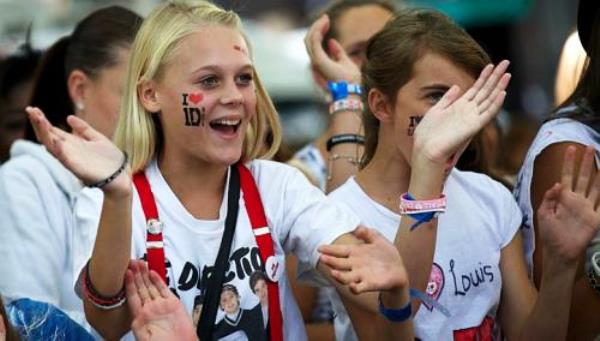 Before I express my own opinion about One Direction, let us first evaluate the band’s success and talent so that I do not come across as biased in whichever extreme opinion I choose to state.
One Direction initially
Before I express my own opinion about One Direction, let us first evaluate the band’s success and talent so that I do not come across as biased in whichever extreme opinion I choose to state.
One Direction initially 
 Source: AminGulgee.com[/caption]
John McCarry, coordinator of the gallery, told me that Amin had attended an exhibition in New York at the
Source: AminGulgee.com[/caption]
John McCarry, coordinator of the gallery, told me that Amin had attended an exhibition in New York at the  Rickshaw (Qadir Jhatial) Source: FRESH Facebook page[/caption]
But at the exhibition, Amin expressed that in a much more direct way, pointing out the
Rickshaw (Qadir Jhatial) Source: FRESH Facebook page[/caption]
But at the exhibition, Amin expressed that in a much more direct way, pointing out the  Condom Dress (Malghalara Kalim). Photo: Bina Shah[/caption]
Next to the dress, another artist stood next to a blue Samsonite vanity case and urged me to look inside the two peepholes she’d made. Inside were miniature hospital wards, complete with white beds and fluffy pillows and screens between the beds.
Condom Dress (Malghalara Kalim). Photo: Bina Shah[/caption]
Next to the dress, another artist stood next to a blue Samsonite vanity case and urged me to look inside the two peepholes she’d made. Inside were miniature hospital wards, complete with white beds and fluffy pillows and screens between the beds.
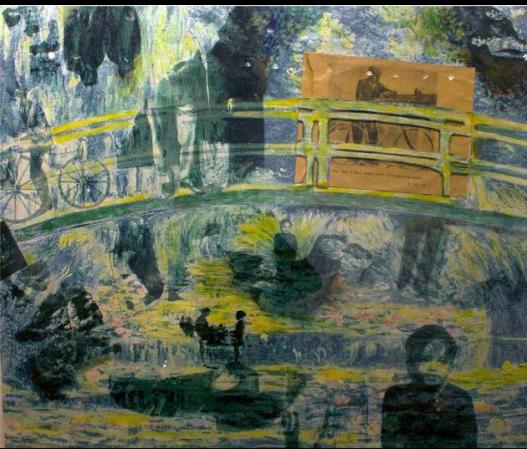 It happened on Monet's bridge (Sehr Jalil). Source: FRESH Facebook page[/caption]
I stopped in front of a large bulls-eye drawn in red paint, overlaid with newspaper headlines describing how many people had been killed in various
It happened on Monet's bridge (Sehr Jalil). Source: FRESH Facebook page[/caption]
I stopped in front of a large bulls-eye drawn in red paint, overlaid with newspaper headlines describing how many people had been killed in various  Untitled (Iffat Tehseen Amjad). Source: FRESH Facebook page[/caption]
There was a painting of small Balochi boys playing marbles in the dust (Nothing is Funnier than Unhappiness, Shabir Ahmed Baloch) with a background of pistachio green that drew my eye to it in the next room.
[caption id="" align="alignnone" width="592"]
Untitled (Iffat Tehseen Amjad). Source: FRESH Facebook page[/caption]
There was a painting of small Balochi boys playing marbles in the dust (Nothing is Funnier than Unhappiness, Shabir Ahmed Baloch) with a background of pistachio green that drew my eye to it in the next room.
[caption id="" align="alignnone" width="592"]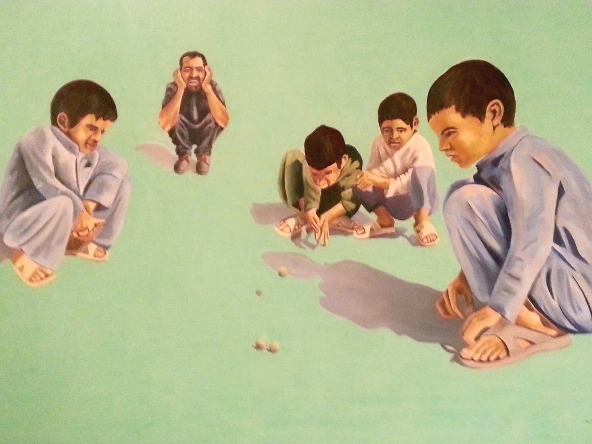 Nothing is Funnier than Unhappiness (Shabir Ahmed Baloch) Photo: Bina Shah[/caption]
Next to it stood a sculpture that consisted of crystals suspended from the ceiling and ending up in a pile on a mirrored tile (Blood Diamond, I can’t seem to find the artist’s name).
[caption id="" align="alignnone" width="337"]
Nothing is Funnier than Unhappiness (Shabir Ahmed Baloch) Photo: Bina Shah[/caption]
Next to it stood a sculpture that consisted of crystals suspended from the ceiling and ending up in a pile on a mirrored tile (Blood Diamond, I can’t seem to find the artist’s name).
[caption id="" align="alignnone" width="337"] Photo: Bina Shah[/caption]
If that wasn’t enough, there were performance artists walking around in costumes too strange to be described, and one who sat in a rocking chair with a veil of flowers over his face, knitting continuously. Then there were video installations, a film projected onto a wall (The X Line, Narjis Mirza), and an entire darkened box that you could walk into and stand to watch a film projected onto the floor (Room, TBP).
[caption id="" align="alignnone" width="337"]
Photo: Bina Shah[/caption]
If that wasn’t enough, there were performance artists walking around in costumes too strange to be described, and one who sat in a rocking chair with a veil of flowers over his face, knitting continuously. Then there were video installations, a film projected onto a wall (The X Line, Narjis Mirza), and an entire darkened box that you could walk into and stand to watch a film projected onto the floor (Room, TBP).
[caption id="" align="alignnone" width="337"]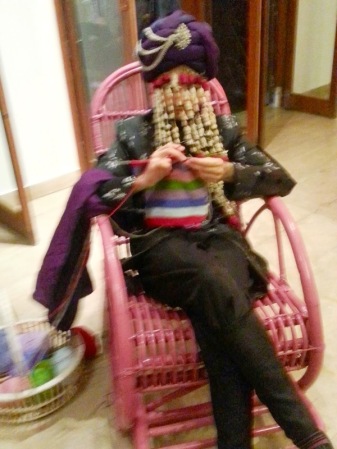 Knitticism (Muhammed Ali) Photo: Bina Shah[/caption]
Knitticism (Muhammed Ali) Photo: Bina Shah[/caption]
 DJ Dynoman Source: FRESH Facebook page[/caption]
But there was no pretence and no playing at ‘cool’ for the young artists who buzzed around the room surrounded by family and friends. They were thrilled at having been given the chance to exhibit their work and to talk about their philosophy and vision. The catalogue, with text written by John McCarry, devotes one page to each artist and her or his work, and is worth reading.
[caption id="" align="alignnone" width="608"]
DJ Dynoman Source: FRESH Facebook page[/caption]
But there was no pretence and no playing at ‘cool’ for the young artists who buzzed around the room surrounded by family and friends. They were thrilled at having been given the chance to exhibit their work and to talk about their philosophy and vision. The catalogue, with text written by John McCarry, devotes one page to each artist and her or his work, and is worth reading.
[caption id="" align="alignnone" width="608"] Construction-Deconstruction 2
Construction-Deconstruction 2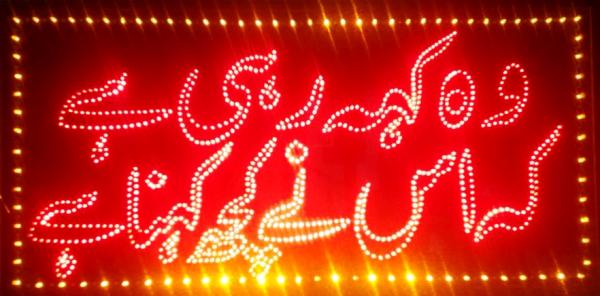 Umber Majeed Source: FRESH Facebook page[/caption]
But it was Pomme Shahbaz whose art design company
Umber Majeed Source: FRESH Facebook page[/caption]
But it was Pomme Shahbaz whose art design company  Nafs ur Rahman (Breath of the Compassionate)
Nafs ur Rahman (Breath of the Compassionate)
 Photo: Coke Studio Facebook page[/caption]
The two giants remain largely ‘separated’ throughout the song. Ustad Sahab’s Alaap was followed by Abida ji’s singing which was then followed by Ustad Sahab’s solo and then Abida ji’s (and the drum’s) crescendo. The sitar should have been given the space to ‘talk’ to the song directly. A continuous memorable short sitar melody should have been woven into the song such that without it, the song would seem empty. There were many places where there could be a ‘nok-jhok’ between the vocalist and the sitar which would have created more balance in the song, but we never got to experience that beautiful possibility. Overall, the two flowed beautifully in parallel, but never did meet. And that is
Photo: Coke Studio Facebook page[/caption]
The two giants remain largely ‘separated’ throughout the song. Ustad Sahab’s Alaap was followed by Abida ji’s singing which was then followed by Ustad Sahab’s solo and then Abida ji’s (and the drum’s) crescendo. The sitar should have been given the space to ‘talk’ to the song directly. A continuous memorable short sitar melody should have been woven into the song such that without it, the song would seem empty. There were many places where there could be a ‘nok-jhok’ between the vocalist and the sitar which would have created more balance in the song, but we never got to experience that beautiful possibility. Overall, the two flowed beautifully in parallel, but never did meet. And that is  Photo: Coke Studio Facebook page[/caption]
The overall “Coors” stringed sound was a great start to the song. Sajjad on the flute was a perfect complement and of course we all love him – even when he whistles! But again, there were moments when the song could have gone a notch up – the harmonies were largely wasted. Instead of humming and singing the same lyrics in different pitch, the harmonies could have vocalised ‘sargams’ instead – something that he himself is very good with.
Strings gave tribute to ‘strings’ by bringing
Photo: Coke Studio Facebook page[/caption]
The overall “Coors” stringed sound was a great start to the song. Sajjad on the flute was a perfect complement and of course we all love him – even when he whistles! But again, there were moments when the song could have gone a notch up – the harmonies were largely wasted. Instead of humming and singing the same lyrics in different pitch, the harmonies could have vocalised ‘sargams’ instead – something that he himself is very good with.
Strings gave tribute to ‘strings’ by bringing  Photo: Coke Studio Facebook page[/caption]
Just like Abida ji brought the Sufi heart of Sindh in her song, the
Photo: Coke Studio Facebook page[/caption]
Just like Abida ji brought the Sufi heart of Sindh in her song, the  Photo: Coke Studio Facebook page[/caption]
And how lucky is Asrar to get
Photo: Coke Studio Facebook page[/caption]
And how lucky is Asrar to get 
 Photo: Ashfaq Wani[/caption]
[caption id="" align="alignnone" width="362"]
Photo: Ashfaq Wani[/caption]
[caption id="" align="alignnone" width="362"] Ghulam Mohiuddin Aajiz Balapora. Photo: Ashfaq Wani[/caption]
[caption id="" align="alignnone" width="578"]
Ghulam Mohiuddin Aajiz Balapora. Photo: Ashfaq Wani[/caption]
[caption id="" align="alignnone" width="578"] Photo: Ashfaq Wani[/caption]
The Ladishah is a literary type of traditional folk genre in Kashmir. It is the art of satire embedded in a song revolving around Kashmiri ethos, and is written and
Photo: Ashfaq Wani[/caption]
The Ladishah is a literary type of traditional folk genre in Kashmir. It is the art of satire embedded in a song revolving around Kashmiri ethos, and is written and  Photo: Ashfaq Wani[/caption]
[caption id="" align="alignnone" width="600"]
Photo: Ashfaq Wani[/caption]
[caption id="" align="alignnone" width="600"] Photo: Ashfaq Wani[/caption]
[caption id="" align="alignnone" width="540"]
Photo: Ashfaq Wani[/caption]
[caption id="" align="alignnone" width="540"] Photo: Ashfaq Wani[/caption]
Traditionally, the orchestra used in Bhand e Pather includes dhol (drum), sawarnai (an instrument that has a strong metallic sound with the impact of open air), nagara (an accompaniment to the dhol) and thalij (metal cymbal). The
Photo: Ashfaq Wani[/caption]
Traditionally, the orchestra used in Bhand e Pather includes dhol (drum), sawarnai (an instrument that has a strong metallic sound with the impact of open air), nagara (an accompaniment to the dhol) and thalij (metal cymbal). The  Photo: Ashfaq Wani[/caption]
[caption id="" align="alignnone" width="544"]
Photo: Ashfaq Wani[/caption]
[caption id="" align="alignnone" width="544"] Photo: Ashfaq Wani[/caption]
There are many children, from all over the valley, seen watching the plays in an effort to understand and study the
Photo: Ashfaq Wani[/caption]
There are many children, from all over the valley, seen watching the plays in an effort to understand and study the 
 Photo: Facebook page[/caption]
Based on a true story, the film centres around artist Margaret Keane (
Photo: Facebook page[/caption]
Based on a true story, the film centres around artist Margaret Keane ( Photo: Facebook page[/caption]
Instead, the film focuses on the more conventional story of Walter and Margaret’s relationship, mostly eschewing a deeper understanding of the more challenging cultural debates, though these are briefly explored through art critic John Canaday (
Photo: Facebook page[/caption]
Instead, the film focuses on the more conventional story of Walter and Margaret’s relationship, mostly eschewing a deeper understanding of the more challenging cultural debates, though these are briefly explored through art critic John Canaday ( Photo: Facebook page[/caption]
The trouble with concentrating on the relationship throughout the film is that Walter is painted as a clichéd pre-Frozen Disney villain – right from the creepy first kiss he shares with Margaret – limiting room for character growth thereafter. And as the film continues hammering home the vilification of Walter Keane, simultaneously campaigns for a sainthood for Margaret Keane, making these polarised characters not only a little boring to watch over an hour and a half but also further reduces the impact the deceit has on other relationships in the film, most importantly, the mother daughter arc, which is left to the wayside and only features in contrived fits and starts.
[caption id="" align="alignnone" width="400"]
Photo: Facebook page[/caption]
The trouble with concentrating on the relationship throughout the film is that Walter is painted as a clichéd pre-Frozen Disney villain – right from the creepy first kiss he shares with Margaret – limiting room for character growth thereafter. And as the film continues hammering home the vilification of Walter Keane, simultaneously campaigns for a sainthood for Margaret Keane, making these polarised characters not only a little boring to watch over an hour and a half but also further reduces the impact the deceit has on other relationships in the film, most importantly, the mother daughter arc, which is left to the wayside and only features in contrived fits and starts.
[caption id="" align="alignnone" width="400"] Photo: Facebook page[/caption]
While the characters are rather one dimensional, Amy Adams is once again pretty remarkable and although she plays a rather feeble character, we still manage to empathise with her by the end and it is arguably safe to assume that she plays Margaret with more nuance than the character might have been written on the page.
[caption id="" align="alignnone" width="400"]
Photo: Facebook page[/caption]
While the characters are rather one dimensional, Amy Adams is once again pretty remarkable and although she plays a rather feeble character, we still manage to empathise with her by the end and it is arguably safe to assume that she plays Margaret with more nuance than the character might have been written on the page.
[caption id="" align="alignnone" width="400"] Photo: Facebook page[/caption]
Waltz, on the other hand, does not go unscathed and is left playing a maniacal character from the start without respite, ending up as an obscenely melodramatic arch villain by the end of the film (though overzealous Weinstein's cleaver-editing may also be a contributing factor).
[caption id="" align="alignnone" width="400"]
Photo: Facebook page[/caption]
Waltz, on the other hand, does not go unscathed and is left playing a maniacal character from the start without respite, ending up as an obscenely melodramatic arch villain by the end of the film (though overzealous Weinstein's cleaver-editing may also be a contributing factor).
[caption id="" align="alignnone" width="400"] Photo: IMDb[/caption]
Big Eyes is the epitome of a case in which the Hollywood-sanitised version of a story is told and a much more fulfilling yet less straightforward structure akin to a riskier independent film is sacrificed for salubrious, commercial fayre.
I'll give it a 2/5.
Photo: IMDb[/caption]
Big Eyes is the epitome of a case in which the Hollywood-sanitised version of a story is told and a much more fulfilling yet less straightforward structure akin to a riskier independent film is sacrificed for salubrious, commercial fayre.
I'll give it a 2/5.
 Photo: Patari website[/caption]
As one clicks on and signs up, the website automatically takes you to the ‘Discover’ section where you can find all the
Photo: Patari website[/caption]
As one clicks on and signs up, the website automatically takes you to the ‘Discover’ section where you can find all the  Photo: Patari website[/caption]
Checking out the
Photo: Patari website[/caption]
Checking out the  Photo: Patari website[/caption]
As you discover, you will see that there are categorisations according to mood as well. You have, from your ‘Break Up’ playlist to ‘Baarish’ (rain) to ‘Funk’ and playlists curated according to the kind of emotions one might want to indulge in.
[caption id="" align="alignnone" width="600"]
Photo: Patari website[/caption]
As you discover, you will see that there are categorisations according to mood as well. You have, from your ‘Break Up’ playlist to ‘Baarish’ (rain) to ‘Funk’ and playlists curated according to the kind of emotions one might want to indulge in.
[caption id="" align="alignnone" width="600"] Photo: Patari website[/caption]
The ‘Break Up’ playlist features all cool artists, from
Photo: Patari website[/caption]
The ‘Break Up’ playlist features all cool artists, from  Photo: Patari website[/caption]
Apart from already present playlists on the website, you can make your own and ‘favourite’ the songs you might want to put on repeat.
There’s also a feature through which artists on board have their bios on their own artist pages. Their songs are categorised according to their albums and are featured on other albums.
[caption id="" align="alignnone" width="600"]
Photo: Patari website[/caption]
Apart from already present playlists on the website, you can make your own and ‘favourite’ the songs you might want to put on repeat.
There’s also a feature through which artists on board have their bios on their own artist pages. Their songs are categorised according to their albums and are featured on other albums.
[caption id="" align="alignnone" width="600"] Photo: Patari website[/caption]
With the international market equipped with websites like Spotify, where artists get a part of the revenue generated through subscriptions, Patari.pk is providing local artists an outlet of the same kind. It has a monitisation program through which the artist will get 30% of the cut from Patari’s revenue. This gives hope to upcoming musicians who think that pursuing music is not a financially feasible option.
However, keeping all praise aside, the real issue Patari will have to face is engaging its customers when it goes into its commercial zone.
Will users pay for the music they want to listen to?
Are users willing to pay for something they can surely find on either
Photo: Patari website[/caption]
With the international market equipped with websites like Spotify, where artists get a part of the revenue generated through subscriptions, Patari.pk is providing local artists an outlet of the same kind. It has a monitisation program through which the artist will get 30% of the cut from Patari’s revenue. This gives hope to upcoming musicians who think that pursuing music is not a financially feasible option.
However, keeping all praise aside, the real issue Patari will have to face is engaging its customers when it goes into its commercial zone.
Will users pay for the music they want to listen to?
Are users willing to pay for something they can surely find on either 
 Photo: Saba Khalid[/caption]
Need help replicating the look; refer to Good Times and Sunday Times galleries for inspiration. Add fake or real LV bag to complete look. Botox on your face is hazb-zaiqa!
2. The conventional (read: boring) models
I don’t encourage underage anorexic models and it’s completely okay if majority of
Photo: Saba Khalid[/caption]
Need help replicating the look; refer to Good Times and Sunday Times galleries for inspiration. Add fake or real LV bag to complete look. Botox on your face is hazb-zaiqa!
2. The conventional (read: boring) models
I don’t encourage underage anorexic models and it’s completely okay if majority of  Photo: Saba Khalid[/caption]
3. The trashy ill-fitting western wear attempts
Pakistani designers, let’s admit something. You can’t do western wear. So that little black dress you made with jamawar looks like the model is wearing her nani’s tikozi. So please, put your scissors away because that chunri jumpsuit looks like rainbow barf. You’re good at eastern wear, embrace your niche and
Photo: Saba Khalid[/caption]
3. The trashy ill-fitting western wear attempts
Pakistani designers, let’s admit something. You can’t do western wear. So that little black dress you made with jamawar looks like the model is wearing her nani’s tikozi. So please, put your scissors away because that chunri jumpsuit looks like rainbow barf. You’re good at eastern wear, embrace your niche and  Photo: Saba Khalid[/caption]
And socialites please accept something. All the western wear you wear from Pakistani designers fits badly and looks ugly. If you really want to farangi it out, get your western attire from abroad or stick to the ikka dukka high street international brands available locally.
4. Feminine clothing for men
Yes, we know you designers want to be avant garde and all that jazz! And it’s hard to be that way with the eastern silhouette for men. But it’s unfair to send a
Photo: Saba Khalid[/caption]
And socialites please accept something. All the western wear you wear from Pakistani designers fits badly and looks ugly. If you really want to farangi it out, get your western attire from abroad or stick to the ikka dukka high street international brands available locally.
4. Feminine clothing for men
Yes, we know you designers want to be avant garde and all that jazz! And it’s hard to be that way with the eastern silhouette for men. But it’s unfair to send a  Photo: Saba Khalid[/caption]
5. How un-fashionable the fashion journalists are
So many people with no fashion background or good taste are reporting on fashion that it baffles me. The list includes me! It baffles me even more how easily fashion journalists are bought! Send a girl a free bag and she’ll write an erotic 50 shades series on your label.
FYI, this pointer should serve as a reminder to
Photo: Saba Khalid[/caption]
5. How un-fashionable the fashion journalists are
So many people with no fashion background or good taste are reporting on fashion that it baffles me. The list includes me! It baffles me even more how easily fashion journalists are bought! Send a girl a free bag and she’ll write an erotic 50 shades series on your label.
FYI, this pointer should serve as a reminder to  Photo: Saba Khalid[/caption]
6. The pretend friendships and the cattiness
This incident is all too common. A designer in the audience gives a standing ovation for a collection and claps as the bashful designer walks at the end of the show. The lights dim and that same appreciative designer turns to his fashion journalist friend and says:
Photo: Saba Khalid[/caption]
6. The pretend friendships and the cattiness
This incident is all too common. A designer in the audience gives a standing ovation for a collection and claps as the bashful designer walks at the end of the show. The lights dim and that same appreciative designer turns to his fashion journalist friend and says:
 Photo: Saba Khalid[/caption]
7. The mafia
It kills me to know that the fashion mafia in Pakistan is so strong that new designers or artists can’t really shine through. Brands tend to work with certain
Photo: Saba Khalid[/caption]
7. The mafia
It kills me to know that the fashion mafia in Pakistan is so strong that new designers or artists can’t really shine through. Brands tend to work with certain  Photo: Saba Khalid[/caption]
Just like the politics, politicians and the corrupt system of the country, the
Photo: Saba Khalid[/caption]
Just like the politics, politicians and the corrupt system of the country, the 

 Soares’s Facebook profile has an array of analogous illustrations. Anyone can relate the striking similarities between Khurram’s design and his unique images. In fact, two of the motifs are the exact copies printed on her cloths.
All around the world, decent designers are aware of the fact that copying or stealing an intellectual property of a person is an awful act for which they can be dragged into a lawsuit. Replication of any artist’s work without his authorisation or legal consent, and paying him no royalty for the used designs absolutely falls under ‘stealing’.
Soares’s instagram
Soares’s Facebook profile has an array of analogous illustrations. Anyone can relate the striking similarities between Khurram’s design and his unique images. In fact, two of the motifs are the exact copies printed on her cloths.
All around the world, decent designers are aware of the fact that copying or stealing an intellectual property of a person is an awful act for which they can be dragged into a lawsuit. Replication of any artist’s work without his authorisation or legal consent, and paying him no royalty for the used designs absolutely falls under ‘stealing’.
Soares’s instagram  Photo: Zara silk printed pants & Sana Safinaz 11a and 11b from Spring Summer 2013.[/caption]
All professionals are ambassadors of their country; anything they do is a representation of the entire nation. And in this regard, Khurram has failed us all. Not only did she rip off the hard work of a professional artist, and commit an intellectual crime, she also brought bad repute to Pakistanis everywhere. Now, just because of her, every Pakistani designer’s integrity will be questioned and their hard work will be marred by the shadow of doubt and cynicism. She has brought dishonour to the Pakistani fashion industry and I do not know how our thriving industry will cope with this blow.
But Khurram is not the first designer who has done something like this. And as the trends are going, I don’t think she will be the last. Not just fashion, almost all of our art-related fields have non-professionals who have copied, plagiarised and ripped off other artist’s intellectual properties.
[caption id="" align="alignnone" width="600"]
Photo: Zara silk printed pants & Sana Safinaz 11a and 11b from Spring Summer 2013.[/caption]
All professionals are ambassadors of their country; anything they do is a representation of the entire nation. And in this regard, Khurram has failed us all. Not only did she rip off the hard work of a professional artist, and commit an intellectual crime, she also brought bad repute to Pakistanis everywhere. Now, just because of her, every Pakistani designer’s integrity will be questioned and their hard work will be marred by the shadow of doubt and cynicism. She has brought dishonour to the Pakistani fashion industry and I do not know how our thriving industry will cope with this blow.
But Khurram is not the first designer who has done something like this. And as the trends are going, I don’t think she will be the last. Not just fashion, almost all of our art-related fields have non-professionals who have copied, plagiarised and ripped off other artist’s intellectual properties.
[caption id="" align="alignnone" width="600"] Photo: Chanel Runway and Origins[/caption]
[caption id="" align="alignnone" width="600"]
Photo: Chanel Runway and Origins[/caption]
[caption id="" align="alignnone" width="600"] Photo: Sana Safinaz Spring Summer 2012 & Emilio Pucci.[/caption]
The most significant step towards stopping plagiarism in Pakistan is to introduce a proper and uncomplicated code of conduct and guarantee its complete observance via an efficient complaint process.
Pakistan Fashion Design Counsel (PFDC) should devise a strategy to put off such
Photo: Sana Safinaz Spring Summer 2012 & Emilio Pucci.[/caption]
The most significant step towards stopping plagiarism in Pakistan is to introduce a proper and uncomplicated code of conduct and guarantee its complete observance via an efficient complaint process.
Pakistan Fashion Design Counsel (PFDC) should devise a strategy to put off such 
 [embed width="620"]http://www.dailymotion.com/video/x2z857o[/embed]
Pakistan was right to
[embed width="620"]http://www.dailymotion.com/video/x2z857o[/embed]
Pakistan was right to  Photo: Hamza Ali Abbasi Facebook page[/caption]
[caption id="" align="alignnone" width="492"]
Photo: Hamza Ali Abbasi Facebook page[/caption]
[caption id="" align="alignnone" width="492"] Photo: Hamza Ali Abbasi Facebook page[/caption]
[fbvideo link="https://www.facebook.com/video.php?v=10153121929723061"][/fbvideo]
But I fail to understand the use of sexism to echo one’s point in a
Photo: Hamza Ali Abbasi Facebook page[/caption]
[fbvideo link="https://www.facebook.com/video.php?v=10153121929723061"][/fbvideo]
But I fail to understand the use of sexism to echo one’s point in a 
 Photo: Canvas Gallery[/caption]
[caption id="" align="alignnone" width="400"]
Photo: Canvas Gallery[/caption]
[caption id="" align="alignnone" width="400"] Photo: Canvas Gallery[/caption]
Another example is that of Imran Qureshi’s installation at the Sharjah Biennial in 2011 titled ‘Blessings upon the Land of my Love’ and ‘And How Many Rains Must Fall before the Stains Are Washed Clean’ at the Metropolitan Museum of Art in 2013. Imran’s work speaks as a cry against the blood that has been shed, his floral forms echoing with hope for regeneration.
[caption id="" align="alignnone" width="600"]
Photo: Canvas Gallery[/caption]
Another example is that of Imran Qureshi’s installation at the Sharjah Biennial in 2011 titled ‘Blessings upon the Land of my Love’ and ‘And How Many Rains Must Fall before the Stains Are Washed Clean’ at the Metropolitan Museum of Art in 2013. Imran’s work speaks as a cry against the blood that has been shed, his floral forms echoing with hope for regeneration.
[caption id="" align="alignnone" width="600"] Imran Qureshi, 'Blessings Upon the Land of my Love', 2011, acrylic and emulsion paint on interlocking brick pavement.
Imran Qureshi, 'Blessings Upon the Land of my Love', 2011, acrylic and emulsion paint on interlocking brick pavement. Imran Qureshi, 'Blessings Upon the Land of my Love', 2011, acrylic and emulsion paint on interlocking brick pavement.
Imran Qureshi, 'Blessings Upon the Land of my Love', 2011, acrylic and emulsion paint on interlocking brick pavement. Imran Qureshi, 'And How Many Rains Must Fall before the Stains Are Washed Clean', 2013, acrylic.
Imran Qureshi, 'And How Many Rains Must Fall before the Stains Are Washed Clean', 2013, acrylic. I Am Karachi project reclaims walls of the city.
I Am Karachi project reclaims walls of the city. Photo: AFP[/caption]
[caption id="" align="alignnone" width="600"]
Photo: AFP[/caption]
[caption id="" align="alignnone" width="600"] Toy guns were collected and destroyed to condemn the use of violence.
Toy guns were collected and destroyed to condemn the use of violence.
 Photo: www.vaslart.org/[/caption]
Ali is also singular in that, unlike his other legendary contemporaries Abdur Rahman
Photo: www.vaslart.org/[/caption]
Ali is also singular in that, unlike his other legendary contemporaries Abdur Rahman  Photo: www.vaslart.org/[/caption]
Photo: www.vaslart.org/[/caption]
